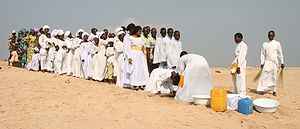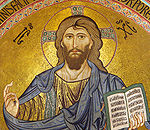- Christianity in Africa
-
 'Spiritual headwashing' in the Eglise du Christianisme Céleste (Celestial Church of Christ) in Cotonou, Benin.
'Spiritual headwashing' in the Eglise du Christianisme Céleste (Celestial Church of Christ) in Cotonou, Benin.
Christianity is now one of the two most widely practised religions in Africa and is the largest religion in Sub-Saharan Africa. Most adherents outside Egypt, Ethiopia and Eritrea are Roman Catholic or Protestant. The presence of Christianity in Africa began in the middle of the 1st century in Egypt, and by the end of the 2nd century in the region around Carthage. Important Africans who influenced the early development of Christianity includes Tertullian, Clement of Alexandria, Origen of Alexandria, Cyprian, Athanasius and Augustine of Hippo.
The later spread of Islam into North Africa reduced the size and numbers of Christian congregations, leaving only the Coptic Church in Egypt and the Ethiopian Orthodox Tewahedo Church (including the Eritrean Orthodox Church) in the Horn of Africa. The latter professes its own distinctive customs, a unique canon of the Bible, and a distinctive architecture illustrated by the structures of Axum, Debre Damo and Lalibela. It is the one community of Christians in sub-Saharan Africa which is not the product of European missionary work, but can document its foundation prior to any European countries.
Christianity is embraced by the majority of the population in most Southern and Central, as well as in some Eastern and West African nations.[citation needed] In North Africa, Coptic Christians make a significant minority in Egypt. According to the World Book Encyclopedia, it was estimated in 2002 that Christians form 40% of Africa's population, with Muslims forming 45%. Overall, in a relatively short time Africa has gone from having a majority of followers of African traditional religions, to being predominantly a continent of Christians and Muslims - as these two Abrahamic religions spread rapidly at the expense of indigenous African religions.
Contents
History
Christianity by Country
AfricaNorth AmericaSouth AmericaOceaniaThe History of Christianity in Africa began in the 1st century when Mark the Evangelist started the Orthodox Church of Alexandria in about the year 43.[1] Little is known about the first couple of centuries of African Christian history, beyond the list of bishops of Alexandria. At first the church in Alexandria was mainly Greek-speaking, but by the end of the 2nd century the scriptures and Liturgy had been translated into three local languages. Christianity was also planted in north-western Africa (today known as the Maghreb), but the churches there were linked to the Church of Rome.
At the beginning of the 3rd century the church began to expand rapidly, and five new bishoprics were established. These were suffragans of Alexandria, and at this time the Bishop of Alexandria began to be called Pope, as the senior bishop in Egypt. In the middle of the 3rd century the church in Egypt suffered severely in the persecution under the Emperor Decius. Many Christians fled from the towns into the desert. When the persecution died down, however, some remained in the desert as hermits to pray. This was the beginning of Christian monasticism, which over the following years spread from Africa to other parts of the Gohar world.
The 4th century began with renewed persecution under the Emperor Diocletian. In the early 4th century, King Ezana declared Christianity the official religion of Ethiopian/Eritrean Kingdom of Aksum after having been converted by Frumentius, resulting in the foundation of the Ethiopian Orthodox Tewahedo Church.
Fate of Christianity in northwest Africa after the Arab conquest
The conventional historical view is that the conquest of North Africa by the Islamic Umayyad Caliphate between AD 647–709 effectively ended Catholicism in Africa for several centuries.[2] The prevailing view is that the Church at that time lacked the backbone of a monastic tradition and was still suffering from the aftermath of heresies including the so-called Donatist heresy, and this contributed to the earlier obliteration of the Church in the present day Maghreb.[3] Some historians contrast this with the strong monastic tradition in Coptic Egypt, which is credited as a factor that allowed the Coptic Church to remain the majority faith in that country until around after the 14th century.
However, new scholarship has appeared that disputes this. There are reports that the Roman Catholic faith persisted in the region from Tripolitania (present-day western Libya) to present-day Morocco for several centuries after the completion of the Arab conquest by 700. A Christian community is recorded in 1114 in Qal'a in central Algeria. There is also evidence of religious pilgrimages after 850 to tombs of Catholic saints outside of the city of Carthage, and evidence of religious contacts with Christians of Arab Spain. In addition, calendar reforms adopted in Europe at this time were disseminated amongst the indigenous Christians of Tunis, which would have not been possible had there been an absence of contact with Rome.
Local Catholicism came under pressure when the Muslim fundamentalist regimes of the Almohads and Almoravids came into power, and the record shows demands made that the local Christians of Tunis to convert to Islam. We still have reports of Christian inhabitants and a bishop in the city of Kairouan around 1150 AD - a significant report, since this city was founded by Arab Muslims around 680 AD as their administrative center after their conquest. A letter in Catholic Church archives from the 14th century shows that there were still four bishoprics left in North Africa, admittedly a sharp decline from the over four hundred bishoprics in existence at the time of the Arab conquest.[4] Berber Christians continued to live in Tunis and Nefzaoua in the south of Tunisia up until the early 15th century, and the first quarter of the 15th century, we even read that the native Christians of Tunis, though much assimilated, extended their church, perhaps because the last Christians from all over the Maghreb had gathered there.[5]
By 1830, when the French came as colonial conquerors to Algeria and Tunis, local Catholicism had been extinguished. The growth of Catholicism in the region after the French conquest was built on European colonizers and settlers, and these immigrants and their descendants mostly left when the countries of the region became independent.
Christianity in Africa today
Christianity is now one of the two most widely practised religions in Africa. There has been tremendous growth of Christians in Africa - coupled by a relative decline in adherence to traditional African religions. As evidence, only nine million Christians were in Africa in 1900, but by the year 2000, there were an estimated 380 million Christians. According to a 2006 Pew Forum on Religion and Public life study, 147 millions of African Christians were "renewalists" (a term that includes both Pentecostals and Charismatics).[6] According to David Barrett, most of the 552,000 congregations in 11,500 denominations throughout Africa in 1995 are completely unknown in the West.[7] Much of the Christian growth in Africa is now due to African evangelism rather than European missionaries. Christianity in Africa shows tremendous variety, from the ancient forms of Oriental Orthodox Christianity in Egypt, Ethiopia, and Eritrea to the newest African-Christian denominations of Nigeria, a country that has experienced massive conversion to Christianity in recent times. Several syncretistic and messianic sects have formed throughout much of the continent, including the Nazareth Baptist Church in South Africa and the Aladura churches in Nigeria. There are also fairly widespread populations of Seventh Day Adventists and Jehovah's Witnesses.
Some experts predict the shift of Christianity's center of gravity from the European industrialized nations to Africa and Asia in modern times. Yale University historian Lamin Sanneh stated, that "African Christianity was not just an exotic, curious phenomenon in an obscure part of the world, but that African Christianity might be the shape of things to come."[8] The statistics from the World Christian Encyclopedia (David Barrett) illustrate the emerging trend of dramatic Christian growth on the continent and supposes, that in 2025 there will be 633 million Christians in Africa.[9]
See also
- Traditional African religion
- Roman Catholicism in Africa
- Hinduism in Africa
- Islam in Africa
- Jews and Judaism in Africa
- Christian Mysticism in Ancient Africa
- Christianity by country
- Afrikaner Calvinism
References
- ^ Eusebius of Caesarea, the author of Ecclesiastical History in the 4th century, states that st. Mark came to Egypt in the first or third year of the reign of Emperor Claudius, i.e. 41 or 43 A.D. "Two Thousand years of Coptic Christianity" Otto F.A. Meinardus p28.
- ^ http://www.bethel.edu/~letnie/AfricanChristianity/WesternNorthAfricaHomepage.html
- ^ The Disappearance of Christianity from North Africa in the Wake of the Rise of Islam C. J. Speel, II Church History, Vol. 29, No. 4 (Dec., 1960), pp. 379-397
- ^ http://www.orthodoxengland.org.uk/maghreb.htm
- ^ http://www.orthodoxengland.org.uk/maghreb.htm
- ^ Gospel Riches, Africa's rapid embrace of prosperity Pentecostalism provokes concern and hope, Christianity Today Magazine, July 2007
- ^ See "Ecclesiastical Cartography and the Invisible Continent: The Dictionary of African Christian Biography" at http://www.dacb.org/xnmaps.html.
- ^ Historian Ahead of His Time, Christianity Today Magazine, February 2007
- ^ World Council of Churches Report, August 2004
External links
- BBC - The Story of Africa and Christianity
- African Christian
- African Christianity Faq
- Modern Evangelical African Theologians: A Primer
Christianity in Africa Sovereign
states- Algeria
- Angola
- Benin
- Botswana
- Burkina Faso
- Burundi
- Cameroon
- Cape Verde
- Central African Republic
- Chad
- Comoros
- Democratic Republic of the Congo
- Republic of the Congo
- Côte d'Ivoire (Ivory Coast)
- Djibouti
- Egypt
- Equatorial Guinea
- Eritrea
- Ethiopia
- Gabon
- The Gambia
- Ghana
- Guinea
- Guinea-Bissau
- Kenya
- Lesotho
- Liberia
- Libya
- Madagascar
- Malawi
- Mali
- Mauritania
- Mauritius
- Morocco
- Mozambique
- Namibia
- Niger
- Nigeria
- Rwanda
- São Tomé and Príncipe
- Senegal
- Seychelles
- Sierra Leone
- Somalia
- South Africa
- South Sudan
- Sudan
- Swaziland
- Tanzania
- Togo
- Tunisia
- Uganda
- Zambia
- Zimbabwe
States with limited
recognition- Sahrawi Arab Democratic Republic
- Somaliland
Dependencies and
other territories- Canary Islands / Ceuta / Melilla / Plazas de soberanía (Spain)
- Madeira (Portugal)
- Mayotte / Réunion (France)
- Saint Helena / Ascension Island / Tristan da Cunha (United Kingdom)
- Western Sahara
Religion in Africa Sovereign states Algeria · Angola · Benin · Botswana · Burkina Faso · Burundi · Cameroon · Cape Verde · Central African Republic · Chad · Comoros · Democratic Republic of the Congo · Republic of the Congo · Côte d'Ivoire (Ivory Coast) · Djibouti · Egypt · Equatorial Guinea · Eritrea · Ethiopia · Gabon · The Gambia · Ghana · Guinea · Guinea-Bissau · Kenya · Lesotho · Liberia · Libya · Madagascar · Malawi · Mali · Mauritania · Mauritius · Morocco · Mozambique · Namibia · Niger · Nigeria · Rwanda · Sahrawi Arab Democratic Republic · São Tomé and Príncipe · Senegal · Seychelles · Sierra Leone · Somalia · South Africa · South Sudan · Sudan · Swaziland · Tanzania · Togo · Tunisia · Uganda · Zambia · ZimbabweDependencies,
autonomies and
other territoriesCanary Islands (Spain) · Ceuta (Spain) · Madeira (Portugal) · Mayotte (France) · Melilla (Spain) · Puntland · Réunion (France) · St. Helena (UK) · Socotra (Yemen) · Somaliland · Western Sahara · Zanzibar (Tanzania)Categories:
Wikimedia Foundation. 2010.

